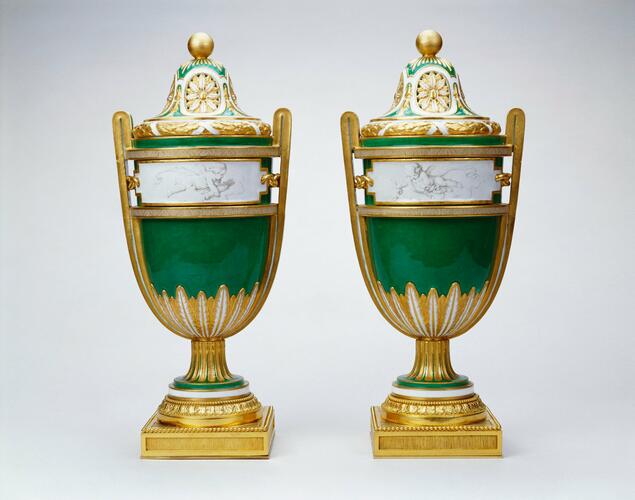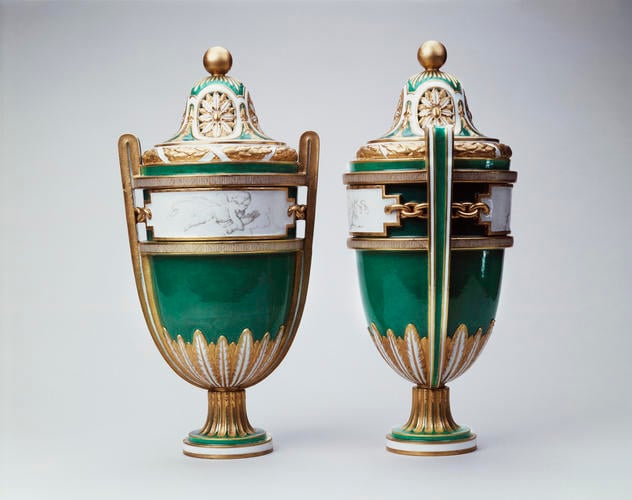Vase à étoiles c. 1776
Soft-paste porcelain, green ground, gilded decoration and gilt bronze | .1 39.9 x 17.4 x 14.8, .2 40.5 x 17.0 x 14.7 cm (parts .a and .b together) | RCIN 2358
-
These urn-shaped vases, which seemingly rest in a cup of raised leaves in two layers (gilded on the under layer and feathered in gold on white on the upper), are supported on a fluted stem which splays out to a stepped circular foot. Applied to the frieze between two projecting mouldings are two raised rectangular panels with indented corners seemingly joined one to the other by gilded links. Handles tightly folded at the top and tapering at the bottom cling to the sides. The bell-shaped covers are crowned by a gilded ball knob (a replacement on .1) above radiating gilded gadroons. Below these are four pierced oval reserves, in each of which is an eight-petalled rosette in white and gold. The reserves alternate with gilded swags of husks in low relief. The bottom of the cover is formed by a gilded laurel torus bound with a white and gold ribbon. The two rectangular panels of the frieze are painted in grisaille with a putto in clouds on the front (scattering roses on .1 and bearing a quiver of arrows on .2) and with crossed palm and oak branches overlain by a laurel wreath on the back.
The gilding is elaborately tooled: the bands, framing the grisaille panels, are alternately burnished and cross-hatched; the flutes of the stem and sides of the handles are decorated with a vermiculated pattern; the projecting mouldings, above and below the frieze, are vertically striated in white and gold with staggered burnishing on the gold lines, thus creating a zigzag pattern.
Each vase stands on a gilt bronze base. They comprise a top ring chased with a band of pendent leaves in two layers below a string of beads and a square plinth with matted panels in the spandrels with vertically striated sunken granulated panels on the four sides and beads along the rebated top edge.
In the late 1760s, when neo-classicism was all the rage, grey monochrome painting became a popular form of decoration at Sèvres, clearly inspired by classical low-relief sculpture. Among the names of the painters responsible for this work, those which recur most frequently are Jean-Baptiste-Etienne Genest, head of the painters’ studio; in 1769 he painted, inter alia, twenty cups with 87 heads and 49 trophies ‘en bas relief’ at 3 livres and 4 livres each, totalling 500 livres. Another specialist, Jacques Fontaine, was paid in 1769 for ‘160 Medaillons Et trophsé en Gris’, at the rate of 1 livre 10 sols each. The third artist who came to concentrate on this type of decoration was Dominique Joffroy. In 1767 he was paid 90 livres for ‘30 Sujets En Enfans Camayeux Sur des nues à difftes pieces’, and in 1768 he was paid 168 livres for ‘56 Enfans sur des nues camayeux’. There seems a strong possibility that the painting in these instances was also in grey monochrome.
At the time the 1826 Carlton House inventory was compiled the vases were not fitted with the gilt bronze bases. These may have been made by Henry J. Hatfield in the late nineteenth or early twentieth century. Although the Hatfields’ stamp on the base-plate often indicates merely that they supplied and fitted this component of the plinth, which they had pierced with socket fixings for securing to the piece of furniture or the chimney-piece, the additional presence of their stamp on the top-plate would suggest that in this instance they may have made the whole base.
Text adapted from French Porcelain: In the Collection of Her Majesty The Queen, London, 2009Provenance
Purchased by George IV from the estate of his mother, Queen Charlotte (d. 17 November 1818). The vases, described as ‘A Pair of Seve China Vases Open work Covers, Green and Gold’, were valued by Thomas Banting on 7 January 1819 at £21. They were entered in the Carlton House receipts’ ledger on 8 January 1819: ‘[Received from] Buckingham House A Pair of Porcelaine Vases Old Seve, with Covers, Green Ground, & Gold, white Pannels at Top, with Cupids and Wreathes Painted on the Pannels, the Covers, Perforated, 14 Inches high to the Top of the Cover’. Recorded in 1826 in the Bow Room, Attic Floor, Carlton House: ‘No.111. A pair of green, gold and white Seve Porcelain Vases and pierced Covers, with ball knobs, and laurel wreath edge, long, flat handles, fluted green, two gold threaded square mouldings round the body, and two medallions chained together, fluted stem and circular base – 14 In. high’.
-
Creator(s)
(porcelain manufacturer)(nationality)(metalworker)Acquirer(s)
-
Medium and techniques
Soft-paste porcelain, green ground, gilded decoration and gilt bronze
Measurements
.1 39.9 x 17.4 x 14.8, .2 40.5 x 17.0 x 14.7 cm (parts .a and .b together)
Category
Object type(s)
Other number(s)
Laking PC : Laking, G.F., 1907. Sèvres Porcelain of Buckingham Palace and Windsor Castle, London – Laking PC 96Alternative title(s)
Pair of vases and covers
Place of Production
Sèvres [France]












